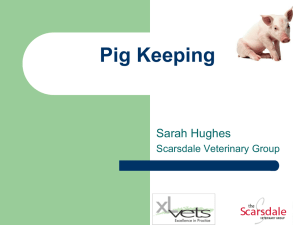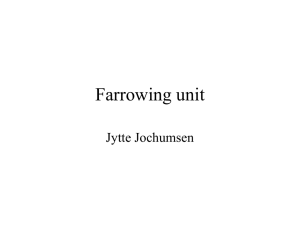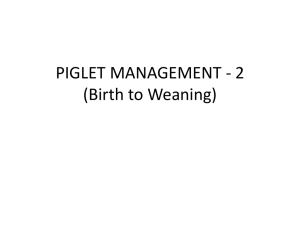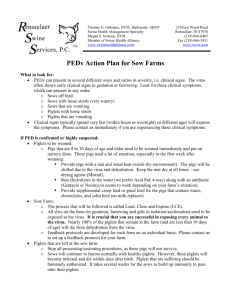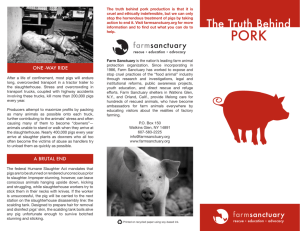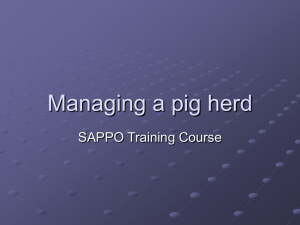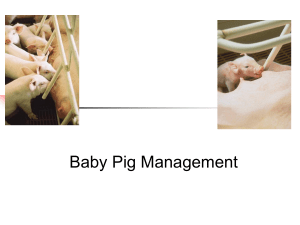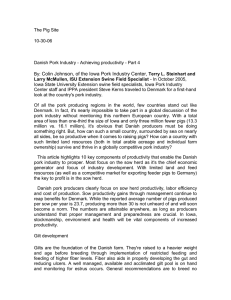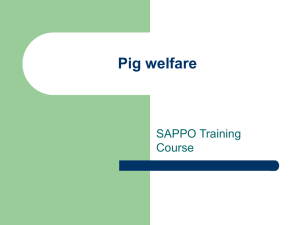Breeder shed - Portec Veterinary Services
advertisement
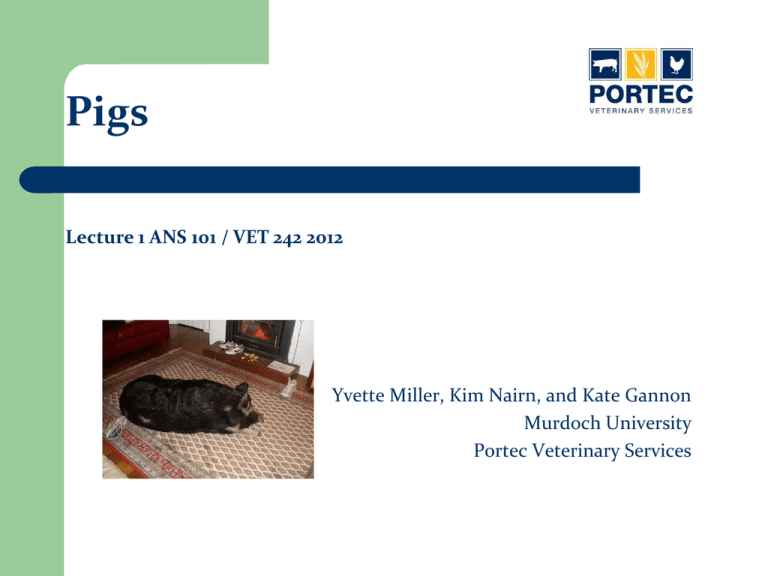
Pigs Lecture 1 ANS 101 / VET 242 2012 Yvette Miller, Kim Nairn, and Kate Gannon Murdoch University Portec Veterinary Services Pig industry overview Why are pigs important? How did the pig industry develop? What pig breeds are involved? How is the industry structured? What are the key performance indicators? What influences these key performance indicators? Why are pigs important? Meat – 40% of the global meat consumption Skin and leather products Pharmaceutical products – heart valves Pleasure and company – pet pigs MEAT Yes… all from one wonderful, magical animal! Pork cuts Country Millions of pigs China 460 (62% global pork eaten in China) India 17 Indonesia 6 Korea North 3 Korea South 9 Malaysia 2 Myanmar 4 New Zealand 0.4 Philippines 12 Taiwan 7 Thailand 7 Vietnam 22 Our impact on the planet – The Carbon Footprint of Pork Food kg CO2-e/kg (20 years) kg CO2-e/kg (100 years) Beef 111.1 55.5 Sheep meat and wool 96.3 32.7 Pig meat 10.5 3.5 Rice 2.4 0.74 Poultry 1.3 0.38 Wheat 0.35 0.32 The Artiodactyla – even toes Pigs Also cattle and camels And even related to the whales - Ambulocetus One of the early pigs Entelodont Today's suina - suborder Hippopotamdae Tayassuidae Suidae Sus scrofa – The domestic pig Large white Hampshire Landrace Duroc Berkshire Tamworth Meishan Duroc x LW Meishan How did the pig industry develop Small numbers of pigs per farmer Side business to other farming = grain production and/or dairy (to use by-products) Feeding pigs in WA Barley and Wheat = main grains (energy) Lupins and canola = protein. Swill feeding is illegal: – – Meat and bone meal does not count (heat treated) Definition is different between states of Australia The global change in pork $ Pork price, feed price and farmers… Where is the grain? Where are the pigs? State NSW Queensland Victoria South Australia Western Australia Percentage 30 21 19 17 12 Western Australia Sows 50000 1000 40000 800 30000 600 20000 400 10000 200 0 0 1992 2001 2004 Year 26,000 sows. Major foreign market Singapore 2007 Producers Sow Herd WA Sows Producers How is the industry structured? Males (boars) Nucleus farm 500 sows Multiplication farms 6000 sows Commercial farms 90,000 sows Females (gilts) How is the farm designed Weaning Grow/finish Farrowing Basic Pig Life Cycle Gestation 115 days Selection Breeding Nucleus farm Slaughter Lets walk the farm… Breeder shed Gestation shed Farrowing shed Weaner shed Grower/Finisher shed And speak the jargon and key performance indicators as we go… Breeder shed • Boar – entire male • Barrow/Castrate – surgically castrated • Gilt – birth to first litter female • Sow – breeding female has had a litter Breeder / Gestation shed – key performance indicators • Breeding/service/mating – As implied • Wean to service/breeding interval – Number of days between weaning and breeding • Repeat/Return – Failure to conceive (18-24 days) • Farrowing rate – Number females farrowed/Number females bred • Culling – Removal from herd/farm (eg. parity >6) Target Wean to re-mate 5 days (service) interval Sow feed in 1.1 tonnes / year Farrowing rate 87 % Interference >7 days >1.2 <82 % Gestation shed Parity = Number of farrowings. Gestation = state of pregnancy Dry Sow = period other than lactating Farrowing shed • Litter = group of piglets reared by a sow • Piglet/Sucker = piglet still on a sow • Farrowing = parturition / giving birth • Lactating = producing milk Farrowing shed – key performance indicators Target Interference Pigs born alive/sow 10.9 <10.4 Pre-weaning mortality Pigs sold per sow per year 10 % >14% 23 <21.5 Pre-weaning mortality – % piglet deaths between birth and weaning Mummified foetus or Mummy Target <1.5% Interference >2.5% Stillborn Target <7% Interference >10% Processing piglets Teeth clipping Castration Iron injection Ear notching Tail docking More jargon for farrowing shed… Fostering – practice of swapping piglets across litters Colostrum – antibody rich milk Body condition score Weaner shed Weaning – removing piglets from the sow (usually 3-5 wks; 5-12kg) Weaner – piglet from weaning until 10 weeks (30kg) Grower/Finisher Shed Grower (30-60kg; 10-16 wks) Finisher (60-110kg; 16-26 wks) Post-weaning – key performance indicators Target Interference Post-weaning mortality Feed conversion ratio (4-100kg) 3% 5% 2.2 >2.4 Average daily gain (g/day) 570 <520 • Post-weaning mortality = % piglet deaths after weaning What influences the key performance indicators? 1. ANIMAL: Genetics 2. ENVIRONMENT (examples): FEED – particle size, FCR, mash vs steam pelleted diets. WATER – water access, flow rates AIR – gases, drafts, temperature FLOOR – stocking rate Code of Welfare - Pigs Web resource http://www.portec.com.au
